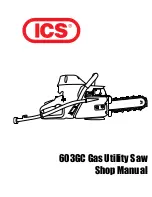
GB
IE
16
NI
Performing Longitudinal Cuts
(Figure 33)
Here, a workpiece is cut in its longitudinal direction. One edge
of the workpiece is pressed against the parallel stop (6) while the
flat side lies on the saw table (1). The saw blade guard (2) must
always be lowered onto the workpiece. The working position du
-
ring longitudinal cutting must never be in a straight line with the
cutting line.
-
Adjust the parallel stop (6) according to the workpiece height
and the desired width.
-
Switch on the saw.
-
Place your hands with the fingers closed together flat on the
workpiece and push the workpiece along the parallel stop
(6) into the saw blade (4).
-
Guide from the side with your left or right hand (depending
on the position of the parallel stop) only up to the front edge
of the saw blade guard (2).
-
Always push the workpiece through to the end of the riving
knife (3).
-
The cutting waste remains on the saw table (1) until the saw
blade (4) is back in its resting position.
-
Secure long workpieces against tilting at the end of the
cutting process! (e.g. unwinding stand etc.)
Cutting narrow Workpieces
(Figure 34)
Longitudinal cuts of workpieces with a width of less than 120
mm always have to be cut with the help of a push stick (19). The
push stick is included in the scope of delivery. Replace a worn or
damaged push immediately.
• Adjust the parallel stop according to the planned workpiece
width.
• Advance the workpiece with both hands, making sure that
you use a push stick (19) as a pushing aid in the vicinity of
the saw blade.
• Always push the workpiece through to the end of the riving
knife.
Caution! In the case of short workpieces, the push
stick should be used from the beginning of the cutting
process.
Cutting very narrow Workpieces
(Figure 35)
For longitudinal cuts of very narrow workpieces with a width of
30 mm and less, a push block must be used without fail. There is
no push block included in the scope of delivery! (Available from
specialist shops) Replace a worn push block as soon as possible.
• The parallel stop should be adjusted to the cutting width of
the workpiece.
• Press the workpiece with the push block against the stop rail
and push the workpiece with the push stick (19) through to
the end of the riving knife.
Performing Bevel Cuts
(Figure 36)
All bevel cuts are made using the parallel stop (6).
-
Adjust the saw blade (4) to the desired angle.
-
Adjust the parallel stop (6) according to the workpiece width
and height.
-
Perform the cut according to the workpiece width
Performing Transverse Cuts
(Figures 29, 37)
-
Push the transverse stop (40) into one of the two grooves
(33) of the saw table. Adjust to the desired angle. The left
groove (33) is to be used if the saw blade (4) also has to be
positioned at an oblique angle.
This will prevent your hand and the transverse stop from
coming into contact with the saw blade guard.
-
Use the stop rail (39).
-
Press the workpiece firmly against the transverse stop (40).
-
Switch on the saw.
-
Push the transverse stop (40) and workpiece in the direction
of the saw blade in order to perform the cut.
-
Caution: Always hold the guided workpiece firmly and never
the free workpiece which is cut off.
-
Always push the transverse stop (40) so far forwards until the
workpiece is completely cut through.
-
Switch the saw off again. Only remove sawing waste when
the saw blade has come to a standstill.
Cutting Chipboard
In order to prevent the cut edges chipping when the chipboard
is cut, the saw blade (4) should be adjusted so that it is not more
than 5 mm above the thickness of the workpiece.
Collection bag for wood residues
The collection bag is only intended for small wood residues. They
can be collected directly from the saw table to keep it clean and
free from obstructions. Under no circumstances may the wood
residues in the collection bag protrude beyond the collection bag
itself. This would prevent the saw table from being fully usable.
This poses a security risk.
Transport
(Fig. 38/39)
1.
Turn the power tool off before it is transported and discon
-
nect it from the power supply.
2.
Pull off any suction hose, that may be connected, from the
suction adapter (18).
3. Insert the saw blade with the help of the crank handle (12).
By turning the saw blade (4) anticlockwise, it moves
downwards.
4. At least two people should carry the power tool. Do not hold
the power tool by the table width extensions. Please only use
the points as shown in (Fig. 38/39) to transport the
machine.
5.
Protect the power tool against knocks, jolts and strong vibra
-
tions, e.g. when it is transported in motor vehicles.
Содержание 315581
Страница 5: ...max 3 5 mm 16 18 14 17 19 15 13 24 24 38 37 36 18 3 29 31 2 5 28 28 35 30 b c d e z 20 4 20 39 6 5...
Страница 36: ...23 25 21 24 26 22 32 16 p h k 6 6 39 6 m 16 o 27 28 39 m r r 6 4 39 39 6 n 36...
Страница 37: ...31 29 m 33 39 34 36 2 32 33 1 2 6 34 6 2 z 35 36 4 6 40 38 37 35 35 19 30 6 p q 37...
Страница 38: ...38 39 37 39 40 42 17 f f f f 7 15 f 40 41 16 16 1 7 7 b e 38...
Страница 39: ...39...
















































